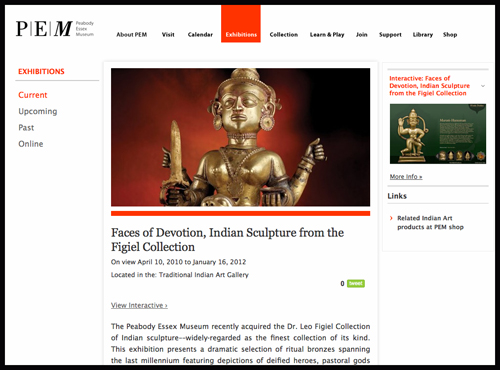The Peabody Essex Museum and the Indian American Community: A Case Study on Community Consultation

I had gone up to Salem, Mass., for work and was lucky enough to have some time to stroll around the Peabody Essex Museum’s India Gallery.
Upon entry to the exhibition Faces of Devotion: Indian Sculpture from the Figiel Collection, I was greeted by bronze sculptures of Shiva and Durga dressed in the Hindu custom. I was struck by the care of the dressing, the ornate garlands draped around the figures’ necks, and tikkas adorned on their foreheads. The placement of the vestments was something I’ve not seen in a museum space since Puja: Expressions of Hindu Devotion. (Check out the online version of this exhibition from Freer-Sackler). It evoked a feeling of entering a temple. Flanking on either side of the Shiva Linga were two signs indicating that a Hindu Priest did the dressings.
This piqued my curiosity.
The idea of community consultation is not a new one in the museum world. But it is a progressive one. It creates an opportunity for curators, conservators, other museum professionals to gain insider knowledge to objects.
Dr. Susan Bean, curator of Indian and Korean art for over 20 years at the Peabody Essex Museum, and guest curator Cathleen Cummings wanted to focus the exhibition on a recently acquired collection of ritual bronzes from Karnataka, India. The bronzes are of the ritualistic folk-art tradition of western and southern India between the 1500s and 1800s. Dr. Bean wanted to focus on the regional aspect of Hindu religious art and to present the ritual bronzes within the context they would normally be seen.
Understanding the sensitive and religious nature of these bronzes, Dr. Bean sought help from the local Hindu community and found a priest who happened to be from Karnataka. She also worked with a Hindu member of museum board overseers. Whatever information passed on from the priest was captured through video and handwritten notes. Dr. Bean may know how to wrap a sari, but she had never seen a priest wrap a sari around an image before. She said they were “[…] not trying to make the gallery a temple, but fill out the aesthetic concept.”
I was so impressed by the tikkas on the foreheads of the images. As a not-so-practicing Hindu, it strikes a religious cord within me and gave authenticity to objects. As a museum professional who works with collections, I freaked out. Tikkas on museum objects. YIKES. So, I asked her about the tikkas on the foreheads of the images. Were they done by the priest? What would the conservator say or do about this request?
She said, “The tikkas were applied by our conservator (!). We hadn’t thought about tikkas at all, but once the images were ‘dressed,’ both our Hindu advisers and helpers thought they didn’t look quite right and really needed tikkas. So, Cathleen Cummings, the guest curator, provided some photographs of enshrined images with tikkas. We had to have the conservator do it, because, as you well know, we had to be really careful that the substances applied would not damage the surface of the metal.”
From this experience, I asked if she would do this again. Dr. Bean stressed that she “endeavor to make that happen.”
If you’re in Salem and tired of looking at witches and broomsticks, check out the Faces of Devotion: Indian Sculpture from the Figiel Collection. The exhibition is open till January 2012.
Also if you happen to be in Salem in April, the Peabody Essex Museum celebrates the arts and culture of India in a weekend-long festival called Sensational India! It brings local groups to do demonstrations, performances and lectures by Mira Nair, James Ivory, and more recently, Madhur Jaffery.
Thanks to Dr. Susan Bean and Karen Karmer Russell from the Peabody Essex Museum.


Discussion